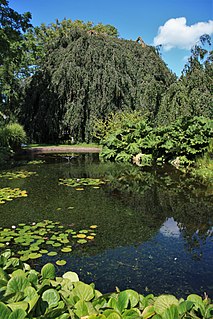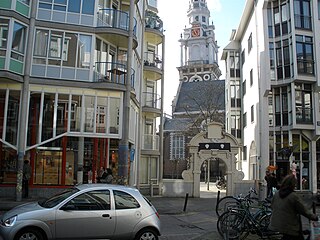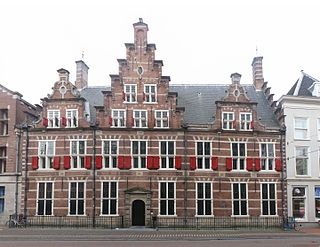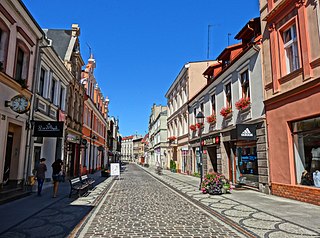
Holland is a geographical region and former province on the western coast of the Netherlands. From the 10th to the 16th century, Holland proper was a unified political region within the Holy Roman Empire as a county ruled by the counts of Holland. By the 17th century, the province of Holland had risen to become a maritime and economic power, dominating the other provinces of the newly independent Dutch Republic.

Leiden is a city and municipality in the province of South Holland, Netherlands. The municipality of Leiden has a population of 119,713, but the city forms one densely connected agglomeration with its suburbs Oegstgeest, Leiderdorp, Voorschoten and Zoeterwoude with 206,647 inhabitants. The Netherlands Central Bureau of Statistics (CBS) further includes Katwijk in the agglomeration which makes the total population of the Leiden urban agglomeration 270,879, and in the larger Leiden urban area also Teylingen, Noordwijk, and Noordwijkerhout are included with in total 348,868 inhabitants. Leiden is located on the Oude Rijn, at a distance of some 20 km (12 mi) from The Hague to its south and some 40 km (25 mi) from Amsterdam to its north. The recreational area of the Kaag Lakes (Kagerplassen) lies just to the northeast of Leiden.

Edam is a town in the northwest Netherlands, in the province of North Holland. Combined with Volendam, Edam forms the municipality of Edam-Volendam. Approximately 7,380 people live in Edam. The entire municipality of Edam-Volendam has 28,492 inhabitants. The name Edam originates from a dam on the little river E or IJe where the first settlement was located and which was therefore called IJedam.

Kampen is a city and municipality in the province of Overijssel, Netherlands. A member of the former Hanseatic League, it is located at the lower reaches of the river IJssel.

The Binnenhof is a complex of buildings in the city centre of The Hague, Netherlands, next to the Hofvijver lake. It houses the meeting place of both houses of the States General of the Netherlands, as well as the Ministry of General Affairs and the office of the Prime Minister of the Netherlands. Built primarily in the 13th century, the Gothic castle originally functioned as residence of the counts of Holland and became the political centre of the Dutch Republic in 1584. It is counted among the Top 100 Dutch heritage sites. The Binnenhof is among the oldest Parliament buildings in the world still in use.

De Adriaan is a windmill in the Netherlands that burnt down in 1932 and was rebuilt in 2002. The original windmill dates from 1779 and the mill has been a distinctive part of the skyline of Haarlem for centuries.

The Amsterdamse Poort is an old city gate of Haarlem, Netherlands. It is located at the end of the old route from Amsterdam to Haarlem and the only gate left from the original twelve city gates.

The siege of Haarlem was an episode of the Eighty Years' War. From 11 December 1572 to 13 July 1573 an army of Philip II of Spain laid bloody siege to the city of Haarlem in the Netherlands, whose loyalties had begun wavering during the previous summer. After the naval battle of Haarlemmermeer and the defeat of a land relief force, the starving city surrendered and the garrison was massacred. The resistance nonetheless was taken as an heroic example by the Orangists at the sieges of Alkmaar and Leiden.

Leiden University Libraries is a library founded in 1575 in Leiden, Netherlands. It is regarded as a significant place in the development of European culture: it is a part of a small number of cultural centres that gave direction to the development and spread of knowledge during the Enlightenment. This was due particularly to the simultaneous presence of a unique collection of exceptional sources and scholars. Holdings include approximately 5,200,000 volumes, 1,000,000 e-books, 70,000 e-journals, 2,000 current paper journals, 60,000 Oriental and Western manuscripts, 500,000 letters, 100,000 maps, 100,000 prints, 12,000 drawings and 300,000 photographs. The library manages the largest collections worldwide on Indonesia and the Caribbean. Furthermore, Leiden University Libraries is the only heritage organization in The Netherlands with three registrations of documents in UNESCO's Memory of the World Register.

The Hortus botanicus of Leiden is the oldest botanical garden of the Netherlands, and one of the oldest in the world. It is located in the southwestern part of the historical centre of the city, between the Academy building and the old Leiden Observatory building.

The Munttoren or Munt is a tower in Amsterdam, Netherlands. It stands on the busy Muntplein square, where the Amstel river and the Singel canal meet, near the flower market and the eastern end of the Kalverstraat shopping street.

The City Hall of Antwerp, Belgium, stands on the western side of Antwerp's Grote Markt. Erected between 1561 and 1565 after designs made by Cornelis Floris de Vriendt and several other architects and artists, this Renaissance building incorporates both Flemish and Italian influences. The Stadhuis is listed as one of the Belfries of Belgium and France, a UNESCO World Heritage Site.

The Sint Antoniesbreestraat is a street in the centre of Amsterdam in the Netherlands. The street runs south from Nieuwmarkt square to the Sint Antoniesluis sluice gates, where it continues as the Jodenbreestraat. The Sint Antoniesbreestraat is primarily a shopping street with a variety of specialty shops. At the corner of Sint Antoniesbreestraat and Hoogstraat is an entry to the Nieuwmarkt stop of the Amsterdam Metro system.
The Zijlpoort was a city gate in Haarlem, built in the 17th century. Salomon de Bray was involved in the design. It is depicted on the painting "De Zijlpoort van Haarlem" by Gerrit Berckheyde. It was named after "Het Zijl", a small stream coming from the dunes, that was later dug out to become the Brouwersgracht. The Zijlpoort was demolished in 1824.

Museum De Lakenhal is the city museum of fine art and history in Leiden, Netherlands. One highlight is its collection of fijnschilder paintings from the Dutch Golden Age. Just like the city, the museum combines a classical appearance with a contemporary character. The broad collection ranges from early works by Rembrandt van Rijn and Lucas van Leyden's Last Judgement to modern classics of De Stijl and artworks created by contemporary artists such as Claudy Jongstra, Atelier van Lieshout and many others.

The Hooglandse Kerk is a Gothic church in Leiden. Its earliest parts date back to the last quarter of the fourteenth century. Most of the current structure dates from the fifteenth century. The brick church was dedicated to St. Pancras and today serves parishioners of the Protestant Church in the Netherlands.

The Burcht van Leiden is an old shell keep in Leiden constructed in the 11th century. It is located at the spot where two tributaries of the Rhine come together, the Oude Rijn and the Nieuwe Rijn. The structure is on top of a motte, and is today a public park.

The Gemeenlandshuis van Rijnland on the Breestraat in Leiden is the oldest Gemeenlandshuis of the Netherlands that kept its function until the current century. Currently, it is still in use by the Hoogheemraadschap van Rijnland, but only for meetings and special occasions. Their day-to-day seat of water management is housed today on the Archimedesweg in Leiden.
The Vischpoort or Vispoort is a late-14th-century city gate and former lighthouse in Harderwijk, Netherlands. The gate, which is located on the historical seaside of the Zuiderzee, is the only one of five gates in the city walls that remains. Between 1851 and 1947 the Vischpoort served as a lighthouse. The Vischpoort is listed as a national heritage site.

Długa Street is the longest street of Old Town district in Bydgoszcz and the most important historically. It stands next to Gdańska Street and Dworcowa Street as one of the most important avenues of downtown Bydgoszcz.




















